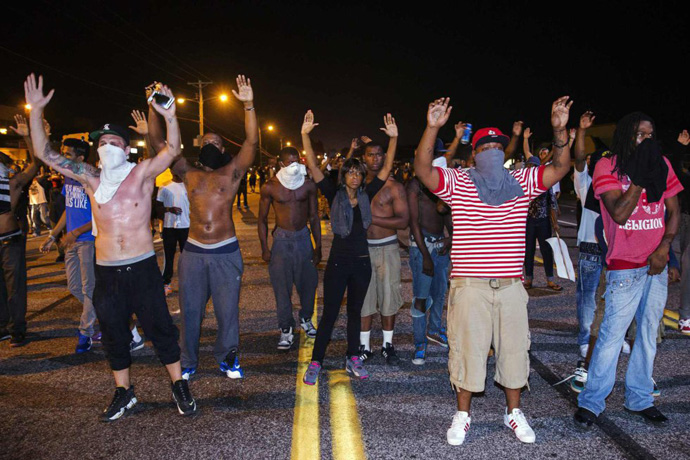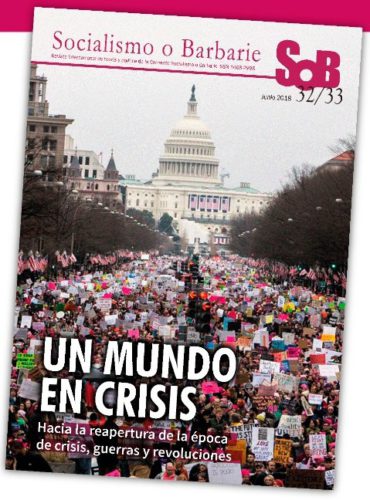
Compartir el post "Three stages of racism in the USA – The fable of “post-racial society” falls."
We closed the article on “Ferguson’s rebellion” saying that in the USA “racism isn’t just, not even mainly a “subjective”, purely “psychological” feeling of “spoiled” white people. It is a structural social relation which has been essential in the social and economical formation of the USA since its colonial prehistory.
As the great American historian Howard Zinn explains, this is born before the USA itself…and it still stands under different shapes:
There is not a country in world’s history in which racism has been more important, for so long a time, as the United States of America. And the problem of «the color line» still exists… How does it start?[…] In the English colonies, slavery developed quickly into a regular institution, into the normal labor relation between blacks and whites. Simultaneously, that special racial feeling developed—whether hatred, contempt, pity or patronization— and it would accompanied the inferior position of blacks in America for the next 350 years —that combination of inferior status and derogatory thought we call racism.” [1]
Understanding what is structural –“labor relation”, “inferior rank”- and what is ideological- “hate, contempt, mercy, paternalism”- and how both relate, is essential to understand why the USA has the sad privilege of coming first in the ranking of racism in world’s history, as one of its own historians recognizes.
Over there, racism has been essential not only to overexploit the discriminated population, but also to maintain in obedience the rest of workers and “subaltern classes”, inciting divisions and clashes with the discriminated. Instead of joining against the common exploiter, they are manipulated to unleash, specially in moments of crisis, “wars of poor against poor”.
In this process there has been, in general, three stages: the first, from slavery to the Civil War (1861-65), where slavery was finally abolished; the second, from there to mid-60s, can be defined as “emancipation without freedom” [[3]]; the third and last stage begins with the extraordinary mobilizations of the 60s, which succeeded In getting the “Civil Rights Bill”…but didn’t lead to the end of racism, it led instead to the co-optation of a small minority (Obama being its main example). The situation of the great mass of African-Americans has been worsening in every sense, from the racist discriminations and attacks to their incomes, jobs and standard of living in general.
Washington and Jefferson, “founding fathers”…and slavers
The United States Declaration of Independence, issued on July 4th of 1776, begins by saying that “we hold these truths to be self-evident, that all men are created equal, that they are endowed by their Creator with certain unalienable Rights, that among these are Life, Liberty and the pursuit of Happiness…”
It didn’t even cross their mind the need to clarify that the expression “all men” did not include black Africans nor American Indians. They took it for granted. It’s just that a good part of the “founding fathers”, including Washington, and specially Tomas Jefferson –editor of this Declaration-, were great landowners, proprietors of hundreds of slaves.
With Independence, the slavery in the USA shot up like a rocket. In 1800 10 million Africans had already been transported to “the land of freedom”. The goods produced by slaves in the world market (cotton being in the first place) multiplied ten times since that date to the Civil War.
In 1857, a slave –named Dred Scott- came up with the idea of going to the Supreme Court to ask for his freedom, arguing that the Declaration of Independence stablishes that all men are “free” and “equal”. The court put him in place by ruling that the slave could not claim his freedom, because he was not “a person, but a property”, that is to say, a thing. [[4]] That is, the racist dehumanization sprouting of the absolute right to private capitalist property.
At the same time, the anti-blacks racism was encouraged, because it turned out to be extremely useful to the great landowners in the subjugation of the “poor whites” of the slaver South of the USA, which could be a potentially explosive social strata. With little to no land, this broad sector could have aimed against the few great and extremely wealthy landowners, as it has happened in other countries. But thanks to racism, they were turned towards hatred to Africans and used to keep them in slavery. They were, also, cannon fodder to the Confederates in the civil war.
We already pointed out that this mechanism of setting, by the way of racism, poor against poor, is a classic in the USA. With all its variants it lives on to the present day, and is one of the main levers of “stability” of the dictatorship of the capital in the USA.
Emancipation without freedom – The Jim Crow stage: slavery is gone but racism remains.
“I have no purpose to introduce political and social equality between the white and black races … I am not nor have ever been, in favor of letting black people vote or be a part of juries, nor allowing them to occupy administration positions, nor marrying white people… […] While they remain together [black and white people] there must be a superior and inferior position. And I, as much as anyone else, wish the superior position to be occupied by the white race…”
Take a guess: Who said this? The founder of the Ku Klux Klan? No. It was Abraham Lincoln, the president that led the civil war against the pro-slavery south, and who finally got the abolition of slavery voted in Congress. [5]
One thing was to abolish slavery, imperious need for capitalism in North America to take the colossal leap which finally took to beat Europe. Another, very different thing, was to end racism. That is to say, for black men and women to stop being “inferior”, for them to have political and civil rights and being able to be elected, for them to have the right to marry white people, etc. That is, to truly free them.
Thus, after a brief period after the Civil War, in which the African American conquered political and civil rights, the victorious bourgeoisie of the North and the defeat of the bourgeoisie of the South came to an agreement to put an end to the party.
All over the country, but especially in the South, the “Jim Crow laws” period began. That is how abundant legislation which imposed the most disgusting inequality and racial segregation was called. There was a bit of everything: prohibition to vote or to be a candidate, prohibition to enter college and schools for white people (which were, of course, the best), to live in “white” neighborhoods, prohibition for black people to enter public places or obligation to do so through a different access, privileged seats for white people in public transport, etc., etc. The labor movement, sadly, was not immune to this racist plague: inequality of salaries, “just for whites” jobs, etc.
The colossal movement of African American population against segregation, which ended in the 60s, ended with the “Jim Crow” stage. The thing is, it had also been combined with another great protest movement, the one of the youth against Vietnam War. This forced the imperialist bourgeoisie to “change everything, so that everything stays the same”.
The (fake) “post-racial society” stage
The American establishment policy to get out of this problem combined several measures. In the first place, the end of the “Jim Crow” laws, which were replaced by legislation which formally consecrated the civil and political rights of black people.
But there were other, no less important measures: On one hand, the co-optation of an African American minority, especially young people, who managed to “carve out a career”. The current president Obama, or Condoleezza Rice (Secretary of state for Bush) were two of the final products of this process of co-optation and “social ascent”. Another, who preceded them, was General Colin Powell, who commanded the first war against Irak (1991) and also was a part of Bush’s government.
Less advertised but no less effective were also the harsh repression and even the murder of leaders of the black movements, especially those that were the most radicalized such as the Black Panthers or the one lead by Malcom X (dead on 1065). Even the moderate pastor Martin Luther King was conveniently murdered in 1968.
With all this, and specially exhibing in this scenario the prominent co-opted, like Obama, in the USA the myth of the “color-blind” or “post-racial” society was imposed. Ferguson destroys this scandalous lie.
Truth is, except for a co-opted minority, the African American masses are worse than ever socially and for them racism isn’t over. Both aspects are inseparable. The crisis unleashed in 2008 made everything worse. Ferguson is a sample of the whole USA.
69% of the population in Ferguson is black, and 29% white. But the mayor, all the councilors but one, the top civil servants and al the cops (but three), are white. Without the «Jim Crow laws», the obstacles and trickery which are put to prevent black people to vote or be candidates are very y effective.
In Ferguson, and the whole region, the poverty rate of black people is 22%, ten points over the general rate, which includes white people. In the USA, the economic crisis has struck al the workers and popular layers. But black people were struck much harder. The «official» unemployment in Ferguson was the 5% in 2000. Now it’s “officially” 13% (and we all know that in the USA the unemployment figure is more tweaked than the inflation one in Argentina). But in the black section it’s 20 to 25%.
The fall of the «net patrimony» of black families is equally dramatic. While from 2005 to 2010 white families dropped an 11% all over the country, black families plummeted a 31%. Also, taking into account figures of 2010, white people are in average six times richer than black and Latinos, a proportion which also grew if compared to the average of 1983.
Summing up: racism strikes the black (and Latin) population with discrimination and abuse. But it also strikes hard on the standard of living. American capitalism isn’t «color blind» in this aspect either.
_______________________________________
[1].- Zinn, Howard “La otra historia de los Estados Unidos”, Siglo XXI, México, 2010, page 27.
[2].- Let’s also point out that another, parallel racism was essential in the social and Economic formation of the USA: racism against the native Americans. In this case, by not being able to exploit them like Africans, anti-native racism was essential to carry on with their «ethnic cleansing»: the extermination of most and the lockdown in «Indian reservoirs» of the rest. In this sense, the current policy of Israel in relation to the Palestine people is inspired in this example, even more than in the «white» of South Africa.
[3].- Zinn, Idem, page. 130.
[4].- Zinn, Idem, page 142.
[5].- Zinn, Idem, page. 143.
By Rafael Salinas


